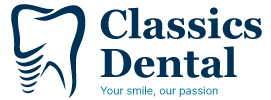Comprehensive Examination
A comprehensive dental examination is a thorough evaluation of a person’s oral health and overall dental condition and involves a series of assessments, examinations, and evaluations to determine the state of a patient’s dental health.
Here’s a summary of what a comprehensive dental examination typically includes:
- Medical History Review: The dentist will discuss the patient’s medical history, including any current medical conditions, medications, allergies, and past dental treatments.
- Oral Examination: The dentist will perform a visual inspection of the patient’s teeth, gums, tongue, and oral tissues to detect any signs of decay, gum disease, oral cancer, or other oral health issues. They may use a mirror, probe, and other dental instruments to examine the teeth and gums more closely.
- Dental X-rays: X-rays may be taken to provide a detailed view of the teeth, roots, jawbone, and surrounding structures. X-rays can help identify hidden dental problems such as cavities, impacted teeth, bone loss, and infections.
- Bite and Jaw Evaluation: The dentist will evaluate the patient’s bite alignment, jaw joint function, and any signs of temporomandibular joint (TMJ) disorders, teeth grinding (bruxism), or other bite-related issues.
- Treatment Plan: Based on the findings of the comprehensive examination, the dentist will develop a personalized treatment plan, which may include recommendations for fillings, extractions, orthodontic treatment, periodontal therapy, or other dental procedures.
Here’s a summary of what a comprehensive dental examination typically includes:
- Medical History Review: The dentist will discuss the patient’s medical history, including any current medical conditions, medications, allergies, and past dental treatments.
- Oral Examination: The dentist will perform a visual inspection of the patient’s teeth, gums, tongue, and oral tissues to detect any signs of decay, gum disease, oral cancer, or other oral health issues. They may use a mirror, probe, and other dental instruments to examine the teeth and gums more closely.
- Dental X-rays: X-rays may be taken to provide a detailed view of the teeth, roots, jawbone, and surrounding structures. X-rays can help identify hidden dental problems such as cavities, impacted teeth, bone loss, and infections.
- Bite and Jaw Evaluation: The dentist will evaluate the patient’s bite alignment, jaw joint function, and any signs of temporomandibular joint (TMJ) disorders, teeth grinding (bruxism), or other bite-related issues.
- Treatment Plan: Based on the findings of the comprehensive examination, the dentist will develop a personalized treatment plan, which may include recommendations for fillings, extractions, orthodontic treatment, periodontal therapy, or other dental procedures.
For all your dental needs, call 0800 454 535
